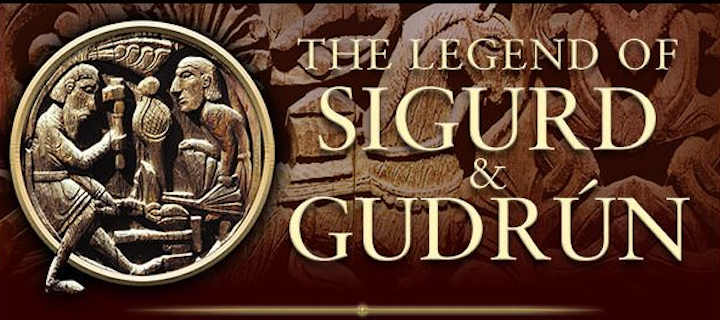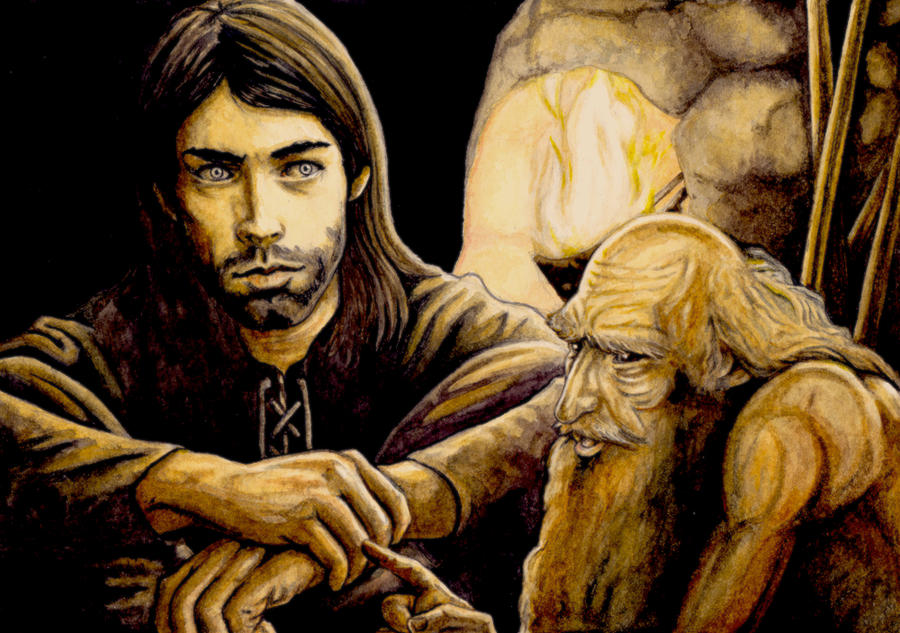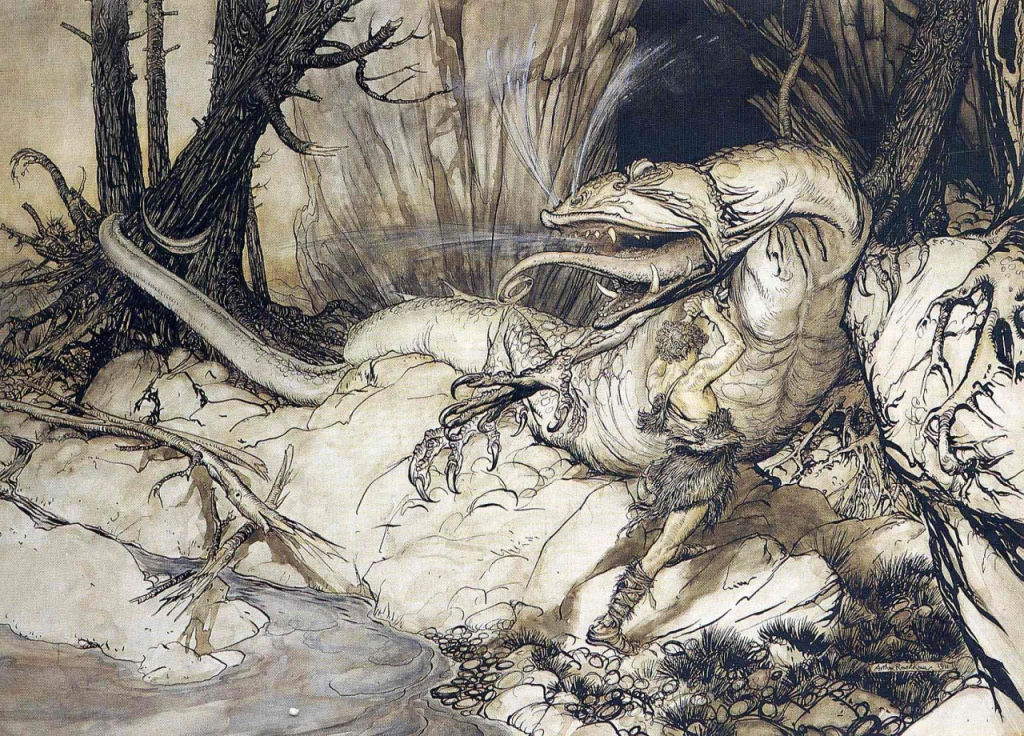The legend of the Volsungs and Sigurd the dragon-slayer of Norse mythology has a messy history. The full scope of the story takes place throughout many poems of the Poetic Edda, some of which are in stark contrast with each other, while Snorri Sturluson’s 13th century Prose Edda provides only a brief glance at the parts concerning Sigurd and Gudrun. Around the same time in the 13th century, the Volsunga Saga was being written, which gives a prose account of the full story of the Volsungs, but there are also contradictions within this telling because it does not attempt to consolidate the plot that exists in the poetry. There is also a great gap in the story, a lacuna, of many missing stanzas in the Poetic Edda, of the Codex Regius manuscript, parts of which Snorri only alludes to, and which the Volsunga Saga attempts to shed some light on what could have occurred in the hole left behind.
J.R.R. Tolkien himself had a go at the legend of Sigurd and Gudrun, which he wrote in eight-line alliterative stanzas. But the difference with Tolkien’s version is that he takes all the source material and consolidates, shapes it, into a more coherent story. Christopher Tolkien, the editor of The Legend of Sigurd and Gudrun, dates his father’s poems to the early 1930s, guessing that it was taken up after he abandoned the Lay of Leithian (his stanzaic version of the tale of Beren and Luthien) near the end of 1931. And now, Tolkien sets off on the difficult task of taking this complex material which, as Christopher Tolkien says, “Those sources themselves, various in their nature, present obscurities, contradictions, and enigmas: and the existence of these problems underlay my father’s avowed purpose in writing the ‘New Lays’” (5). It’s for this purpose that Tolkien sets out to compose his own version, which in first reading can be a lot and a little confusing, but it is still brilliantly put together. And for this series I will just be concentrating on Sigurd’s part, as Tolkien calls it, Volsungakvida En Nyja (The New Lay of the Volsungs).
Tolkien’s lay of Sigurd is interesting because it starts off with the “Upphaff,” which is basically the “Voluspa,” of the Poetic Edda, where the Seeress tells Odin the fate of the gods and the world at Ragnarok, but it’s unique because Tolkien adds in a unifying theme with the idea of Odin’s Chosen, who is Sigurd, and that everything is designed by Odin in bringing about his fate. Which also allows for questions of fate and freewill, since the Seeress says:
If in day of Doom
One deathless stands,
Who death hath tasted
And dies no more,
The serpent-slayer,
Seed of Odin,
Then all shall not end
Nor Earth perish.
If being the key word here. This results in Odin going out into Midgard sowing his seed to engender Sigurd’s birth.
In “Andvara-Gull,” (Andvari’s Gold) this is where we have the background which really sets everything into motion. Tolkien writes it similarly to the source material where after Loki strikes Otr with a stone, for really no reason (which is also a very Loki thing to do) and kills him, “loosing evil,” Hreidmar then demands a ransom. Loki first goes to Ran, the queen of the Aegir, which she gives him a net “noosed with evil.” Loki catches Andvari and demands payment, but Andvari withholds a ring, which then he curses it saying,
My ring I will curse
With rue and woe!
Bane it bringeth
To brethren two;
Seven princes slays;
Swords it kindles –
End untimely
Of Odin’s hope.
Here again the overarching theme is brought in of Odin’s Chosen, which of course is not in the source material. And it’s interesting that Andvari would even know this. Loki relays the message, but Odin says,
“Whom Odin chooseth
Ends not untimely,
Though ways of men
He walk briefly.
In wide Valholl
He may wait feasting –
It is ages after
That Odin looks.”
For him, everything seems to be part of the plan.
In the Poetic Edda, in “The Lay of Regin,” this whole story of Andvari’s gold is told to Sigurd anecdotally by Regin, since we are first told that he’s the one who fosters Sigurd. The same sequence of events occurs with Loki killing Otter and, again, he first goes to Ran to ger her net to catch Andvari. Again, he holds back the ring and curses it saying,
“That gold, which Gust owned.
Will be the death of two brothers,
And cause of strife between eight princes;
My treasure will be no use to anyone.”
Which is similar to the way Tolkien phrases it, with Regin saying eight princes instead of Tolkien’s seven, although there’s never really any indication who the princes are specifically referring to. But the rest of the Lay then tells the story of Fafnir killing Hreidmar and denying Regin any of gold. Regin then eggs Sigurd on to kill Fafnir.
The Prose Edda is very succinct in telling the story, but with the difference in Loki is sent to Svartalfaheim, the land of the swart (dark) elves, where Andvari lives. But instead of needing to go to Ran, Loki just catches him there. And when Andvari withholds the ring, he says he would be able to produce more wealth from it, but Loki takes it any way. It says, “The dwarf called after him, saying that the ring would be the death of whoever possessed it.”
In the Saga of the Volsungs, like “The Lay of Regin,” Sigurd is being fostered by Regin, telling him to kill Fafnir, and when Sigurd asks him why, Regin tells the story, which is more like a mixture of the other sources. Loki kills Otr, Hreidmar demands a ransom, so he goes back to Andvari’s Fall where he catches Andvari in a net. Andvari curses the ring. “The dwarf went into the rock and said that the gold ring would be the death of whoever owned it, and the same applied to all the gold.”
So, the big thing Tolkien is doing differently in these two scenes is just to set up Odin as the designer of when he wants things to take place, as the designer of Fate. Therefore, Tolkien gives this scene more purpose than just about Loki throwing a rock at an otter which sets everything into motion.
Works Cited
The Poetic Edda. Translated by Carolyne Larrington, Oxford University Press, 2014
The Saga of the Volsungs. Translated by Jesse L. Byock, Penguin Books, 1999.
Sturluson, Snorri. The Prose Edda. Penguin Books Ltd, 2005.
Tolkien, J.R.R. The Legend of Sigurd and Gudrún. Edited by Christopher Tolkien, HarperCollins Publishers, 2009.




